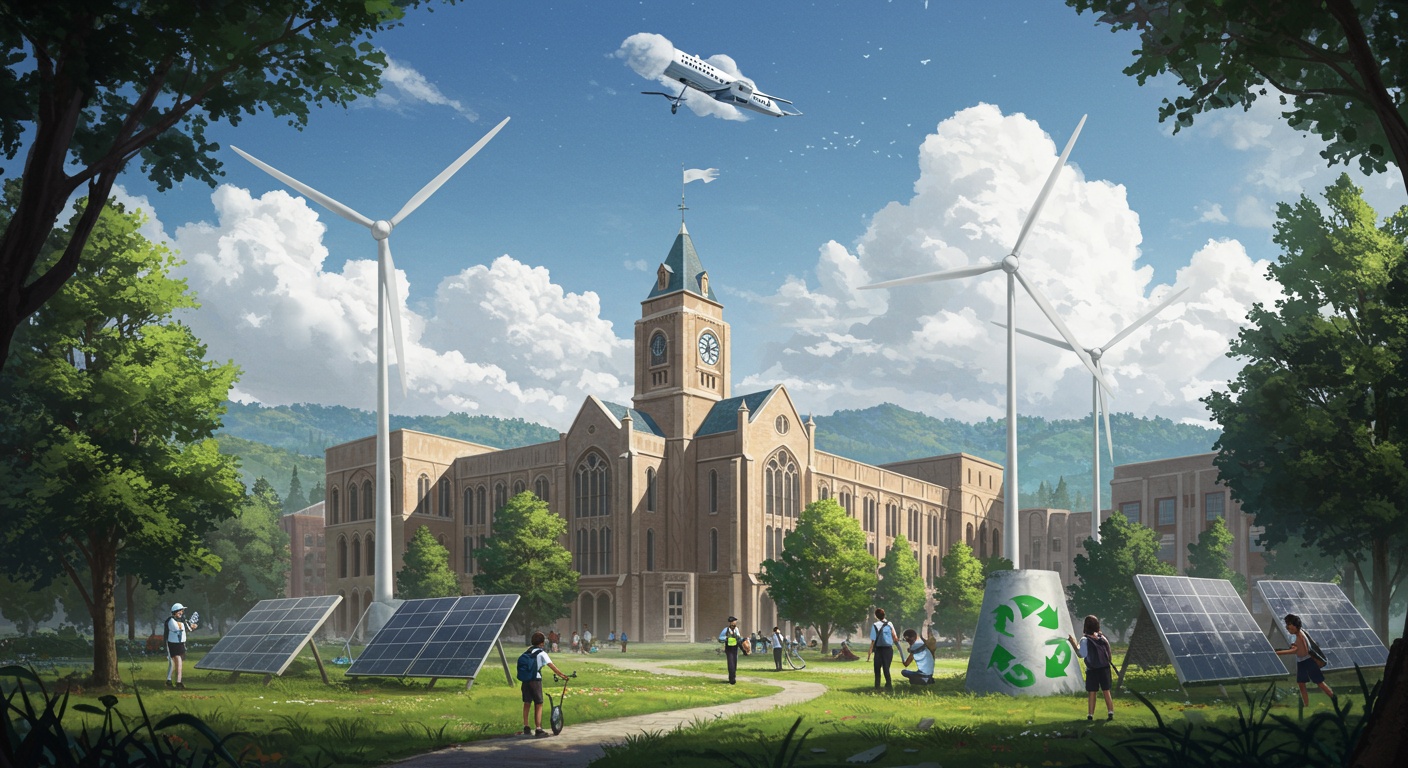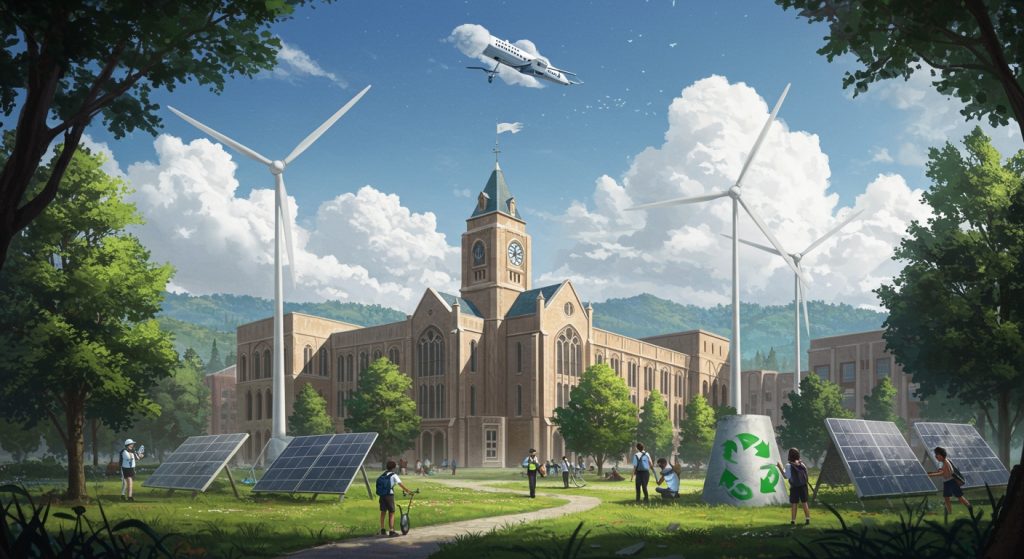Universities, traditionally ivory towers of knowledge, are now increasingly becoming epicenters of environmental action. Driven by student activism and a growing awareness of climate change, institutions are implementing ambitious sustainability initiatives. We’ve moved beyond simple recycling programs; campuses are now investing in renewable energy infrastructure like solar panel arrays, designing net-zero buildings using materials like cross-laminated timber. Even developing carbon offset programs focused on local ecosystems. A recent trend involves universities partnering with local communities to address regional environmental challenges, such as restoring polluted waterways or promoting sustainable agriculture. Examining these diverse approaches reveals not only the tangible environmental impact. Also the critical role universities play in shaping the next generation of environmental stewards.

Understanding Sustainability in Higher Education
Sustainability in higher education goes beyond just recycling bins and solar panels. It encompasses a holistic approach to minimizing environmental impact, promoting social responsibility. Ensuring long-term economic viability within the university ecosystem. This includes everything from curriculum design and research initiatives to campus operations and community engagement.
A truly sustainable university integrates environmental consciousness into its core values and practices. This often involves:
- Reducing carbon footprint: Implementing energy-efficient technologies, promoting sustainable transportation. Investing in renewable energy sources.
- Conserving resources: Minimizing water consumption, reducing waste generation. Promoting responsible sourcing of materials.
- Promoting environmental literacy: Integrating sustainability concepts into academic programs and raising awareness among students, faculty. Staff.
- Fostering a culture of sustainability: Encouraging sustainable behaviors, supporting student-led initiatives. Partnering with local communities.
Key Sustainability Initiatives on University Campuses
Universities are implementing a wide range of initiatives to reduce their environmental impact and promote sustainability. Here are some of the most common:
Renewable Energy Adoption
Many universities are investing in renewable energy sources such as solar, wind. Geothermal to power their campuses. This can significantly reduce their reliance on fossil fuels and lower their carbon emissions.
Solar Power: Installing solar panels on rooftops and in solar farms to generate electricity. For example, Arizona State University has one of the largest campus-based solar power programs in the U. S.
Wind Power: Purchasing wind energy credits or installing wind turbines on or near campus. Iowa State University, located in a windy region, utilizes wind energy extensively.
Geothermal Energy: Utilizing geothermal energy for heating and cooling buildings. Ball State University has a large geothermal system that heats and cools 47 buildings on campus.
Waste Reduction and Recycling Programs
Universities are implementing comprehensive waste reduction and recycling programs to minimize the amount of waste sent to landfills.
- Single-Stream Recycling: Making it easier for students and staff to recycle by allowing them to put all recyclable materials into one bin.
- Composting Programs: Collecting food waste and yard waste for composting, which can then be used to enrich soil on campus.
- E-Waste Recycling: Properly disposing of electronic waste to prevent harmful chemicals from entering the environment.
- Reducing Single-Use Plastics: Encouraging the use of reusable water bottles, coffee cups. Shopping bags.
Water Conservation
Universities are implementing water conservation measures to reduce their water consumption.
- Low-Flow Fixtures: Installing low-flow toilets, showerheads. Faucets to reduce water usage in restrooms and dormitories.
- Water-Efficient Landscaping: Using native plants that require less water and implementing efficient irrigation systems.
- Rainwater Harvesting: Collecting rainwater for irrigation and other non-potable uses.
Sustainable Transportation
Universities are promoting sustainable transportation options to reduce traffic congestion and air pollution.
- Bike-Sharing Programs: Providing students and staff with access to bicycles for commuting around campus.
- Public Transportation Subsidies: Offering discounts or free passes for public transportation.
- Electric Vehicle Charging Stations: Installing charging stations for electric vehicles to encourage their use.
- Carpooling Programs: Encouraging students and staff to carpool to reduce the number of vehicles on campus.
Green Building Design
Universities are incorporating green building design principles into the construction and renovation of campus buildings.
- LEED Certification: Designing buildings to meet the Leadership in Energy and Environmental Design (LEED) standards, which recognize environmentally friendly and sustainable building practices.
- Energy-Efficient HVAC Systems: Installing high-efficiency heating, ventilation. Air conditioning (HVAC) systems to reduce energy consumption.
- Sustainable Building Materials: Using recycled and locally sourced building materials to minimize environmental impact.
- Daylighting: Designing buildings to maximize natural light and reduce the need for artificial lighting.
The Environmental Impact of Green University Initiatives
The environmental impact of green university initiatives can be substantial. By reducing their carbon footprint, conserving resources. Promoting sustainable practices, universities can make a significant contribution to environmental protection.
Reduced Carbon Emissions
Investing in renewable energy sources and implementing energy-efficient technologies can significantly reduce a university’s carbon emissions. This can help to mitigate climate change and improve air quality.
Consider the University of California system, which has committed to becoming carbon neutral by 2025. Their initiatives include investing in renewable energy, improving energy efficiency. Reducing transportation emissions. This commitment demonstrates a significant effort to combat climate change at an institutional level.
Conserved Resources
Water conservation measures and waste reduction programs can help to conserve valuable resources. This can reduce the strain on local water supplies and minimize the amount of waste sent to landfills.
For instance, composting programs not only reduce landfill waste but also create valuable compost that can be used to enrich soil on campus, reducing the need for synthetic fertilizers.
Improved Air and Water Quality
Sustainable transportation initiatives can reduce traffic congestion and air pollution. By promoting biking, walking. Public transportation, universities can help to improve air quality in the surrounding community. Also, reducing the use of chemical fertilizers and pesticides on campus grounds can help to protect water quality.
Enhanced Biodiversity
Using native plants in landscaping and creating green spaces on campus can help to enhance biodiversity. This can provide habitat for wildlife and improve the aesthetic appeal of the campus.
Universities are increasingly recognizing the importance of creating pollinator gardens and restoring natural habitats on campus to support biodiversity and ecosystem services.
Challenges and Opportunities for Green Universities
While many universities are making progress in sustainability, there are still challenges to overcome. These include:
- Funding constraints: Implementing sustainability initiatives can be expensive. Universities may face budget limitations.
- Competing priorities: Sustainability may not always be a top priority for university administrators, who may be focused on other issues such as academic rankings and research funding.
- Lack of awareness: Some students, faculty. Staff may not be fully aware of the importance of sustainability or how they can contribute to it.
- Resistance to change: Implementing new sustainability initiatives may face resistance from some members of the university community who are unwilling to change their habits.
But, there are also many opportunities for green universities. These include:
- Cost savings: Sustainability initiatives can often lead to cost savings in the long run, such as through reduced energy and water consumption.
- Enhanced reputation: Universities with strong sustainability programs can attract students, faculty. Staff who are committed to environmental stewardship.
- Research opportunities: Sustainability provides opportunities for research in areas such as renewable energy, green building design. Environmental policy.
- Community engagement: Universities can partner with local communities to promote sustainability and address environmental challenges.
The Role of Education and Finance in Achieving Sustainability Goals
Education plays a crucial role in fostering a culture of sustainability on university campuses. Integrating sustainability concepts into the curriculum can raise awareness among students and equip them with the knowledge and skills they need to address environmental challenges. This includes courses in environmental science, sustainable development. Environmental policy. Moreover, universities can offer workshops and training programs for faculty and staff to promote sustainable practices in their departments and offices. By fostering environmental literacy, universities can empower their community members to make informed decisions and take action to protect the environment.
Finance is also essential for achieving sustainability goals. Universities need to allocate sufficient resources to support sustainability initiatives, such as renewable energy projects, waste reduction programs. Green building design. This may involve seeking external funding through grants and donations, as well as incorporating sustainability considerations into investment decisions. Investing in sustainable infrastructure and technologies can not only reduce environmental impact but also generate long-term cost savings and enhance the university’s reputation. Also, universities can explore innovative financing mechanisms, such as green bonds and revolving loan funds, to support sustainability projects.
Case Studies of Leading Green Universities
Several universities are leading the way in sustainability. Here are a few examples:
Stanford University
Stanford University has implemented a comprehensive sustainability program that includes renewable energy, water conservation, waste reduction. Green building design. The university has invested in a large-scale solar power plant and has reduced its water consumption by 30% since 2000.
University of California, Berkeley
The University of California, Berkeley, has committed to becoming carbon neutral by 2025 and has implemented a range of sustainability initiatives, including energy efficiency upgrades, renewable energy procurement. Sustainable transportation programs.
Arizona State University
Arizona State University has one of the largest campus-based solar power programs in the U. S. And has implemented a comprehensive waste reduction program that includes recycling, composting. Waste diversion initiatives.
Oberlin College
Oberlin College has a long history of environmental activism and has implemented a range of sustainability initiatives, including a carbon neutrality commitment, a sustainable agriculture program. A green building design policy.
These examples demonstrate that universities can make a significant impact on sustainability by implementing comprehensive programs and committing to ambitious goals.
Conclusion
Green universities are not just about solar panels and recycling bins; they represent a profound shift in values, embedding sustainability into the very fabric of higher education. We’ve seen how initiatives like comprehensive carbon neutrality plans, such as the one being implemented at the University of California system. Student-led movements demanding divestment from fossil fuels are reshaping campuses. My personal tip? Start small. Advocate for reusable coffee cups in your department or volunteer in a campus garden; collective action begins with individual commitment. Looking ahead, the trend towards “living labs,” where campus infrastructure becomes a testing ground for sustainable technologies, will only accelerate. Remember, creating a greener university is a continuous journey, not a destination. Embrace innovative solutions, push for institutional change. Inspire others to join the movement. The future of our planet depends on it. The change starts with us.
More Articles
Leveraging Campus Resources: A Guide for Business Management Students
Maximize Your Potential: University Course Career Services Support Guide
University Course: Crafting Your Personal Brand for Career Success
Mastering University: Proven Strategies to Excel in Challenging Courses
FAQs
So, what exactly is a ‘green university’? Is it just covered in ivy?
Haha, not quite! While a nice campus aesthetic is a bonus, a green university is one that’s actively working to reduce its environmental footprint and promote sustainability in everything it does. Think energy conservation, waste reduction, sustainable food sourcing. Incorporating environmental awareness into the curriculum and campus culture.
Okay, that makes sense. But what kind of initiatives are we talking about? Give me some examples!
You got it! Common initiatives include installing solar panels, implementing comprehensive recycling and composting programs, offering incentives for using public transportation or biking, building green buildings (LEED certified, for example), reducing water consumption. Even offering courses and research opportunities focused on sustainability.
Why should I even care if a university is ‘green’ or not? What’s in it for me?
Great question! For starters, a commitment to sustainability often translates to a more innovative and forward-thinking institution. Plus, you’ll be part of a community that values environmental responsibility. You might also see practical benefits like lower energy bills in dorms, access to locally sourced food. Opportunities to get involved in sustainability projects. And, of course, you’re contributing to a healthier planet!
What impact do these green initiatives actually have? Is it really making a difference?
Absolutely! Green universities can significantly reduce their carbon emissions, waste generation. Water usage. They can also contribute to biodiversity conservation and promote sustainable practices within the broader community. Think of it as a ripple effect – universities are educating future leaders and demonstrating that sustainable living is possible and desirable.
How do universities measure their environmental impact? Is there like, a ‘green score’ or something?
There are definitely ways to measure it! Many universities track metrics like greenhouse gas emissions, waste diversion rates, water consumption. Energy usage. They might also use frameworks like the Sustainability Tracking, Assessment & Rating System (STARS) to assess their performance and identify areas for improvement. So, while there isn’t one universal ‘green score,’ there are ways to compare universities’ sustainability efforts.
So, if I’m looking at colleges, how can I tell if one is really committed to sustainability, or if it’s just greenwashing?
That’s a smart question to ask! Look beyond the marketing materials. Check out their sustainability reports (most green universities publish them), see if they have a dedicated sustainability office. Research their specific initiatives. Also, look for student-led sustainability groups – that’s a good sign that the commitment runs deep. And don’t be afraid to ask questions during campus visits!
Are there any unexpected benefits of universities going green?
Definitely! Sometimes, going green can lead to cost savings in the long run (think lower energy bills!). It can also attract and retain talented students and faculty who value sustainability. Plus, it can foster a stronger sense of community and promote innovation in areas beyond just environmental issues.



